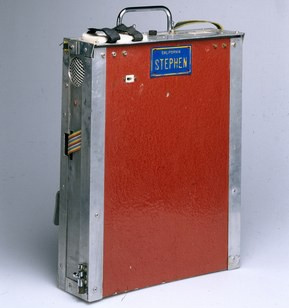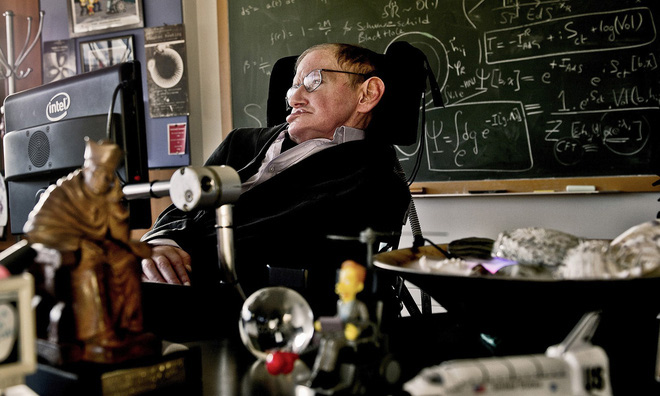This is the technology that helped Stephen Hawking talk to the world when he lost his ability to speak from 1985
In 21, Stephen Hawking suffered from muscular atrophy, and after an operation in 1985, he lost his ability to speak. At first, he had to use spelling boards to talk, raising an eyebrow to pick out the right letters, to form sentences.
Hawking then joined Martin King, a physicist who designed a new communication system. This system uses a computer program called Equalizer that allows users to select words and commands on the computer with the click of a button.
The first Equalizer runs on an Apple II computer, attached to a speech engine from Speech Plus. Later, the system was redesigned to mount Hawking's armrests, allowing him to speak at a speed of 15 words per minute using the thumb movement.

Stephen Hawking in 1986.
But in 2008, Hawking could not press the talk button anymore because the illness was getting worse. His assistant created a device called "cheek button - cheek switch". This device moves the mouse to move continuously through the letters of the alphabet. It is mounted on the glass and uses pink rays to record the movement of the right face muscles when Hawking 'chooses' the character. Then those characters are transmitted to a synthetic computer and converted into speech for pronunciation. Thanks to this device, Hawking can write email, surf the web and even write books.
However, due to the harmful effects of the disease, Hawking's ability to control muscle is decreasing. By 2011, Hawking could only say 2 words per minute, when he sent a letter to Gordon Moore, asking if Intel could help him.

Earlier, Hawking met Gordon Moore at a conference in 1997. At that time, Gordon Moore offered to upgrade the computer he was using to communicate from the AMD platform to Intel and provide a computer. Designed specifically for Hawking, research support technology and upgrade communication systems every two years.
Upon receiving the letter, Moore asked Justin Ratter, the current CTO of Intel. A group of expert human-machine interaction has been established to help Hawking regain the speed of communication as before.
 This is Hawking's "voice" in 1999.
This is Hawking's "voice" in 1999.
At that time, Hawking's communication system was a program called EZ Keys, an improved version of software previously designed by Word Plus. Thanks to a virtual keyboard, an algorithm to guess basic words and a webcam, EZ Keys allowed Hawking to use the mouse to manipulate Windows, surf the web in Firefox, compose lectures on Notepad and make Skype calls.
The latest, most modern solutions have been offered by the research team but are not effective. The eye tracking software did not work because his eyelids collapsed. Unable to apply technology to make an EEG-based computer not catch a strong enough signal from Hawking's brain.

After many trials, the research team came up with various upgrade versions but could not make Hawking happy. Finally, they set up a system to record the entire process of using Hawking's computer, typing Hawking, typing when tired, using the mouse, dragging the size of any window. After studying that 10-hour video, the researchers came up with a special system. After a few months, having made many improvements, they created a software that was just as appealing to Hawking. It uses a SwiftKey word prediction system combined with many of Hawking's documents in Intel's new system to predict from Hawking's intention to say.
In addition, the system has a series of shortcuts that allow Hawking to perform various tasks such as speaking, searching or composing email; a lecture control software .
Intel's new solution helps Hawking double the speed of "speaking", the speed of performing other operations also increased by about 10 times compared to before.
Hawking enjoyed his computer voice, which was created by engineer Dennis Klatt in the 1980s. Hawking's voice was called "Perfect Paul - Perfect Paul".

The research team also plans to make further improvements: as a wheelchair driver system using Hawking's chin, unfortunately, Hawking did not have the opportunity to use them. Stephen Hawking died on March 14, 2018 in Vietnam time.
See more:
- Stephen Hawking's life through photos
- Download Stephen Hawking's space doctoral thesis - Download Properties of Expanding Universes
- Stephen Hawking made a terrifying remark about the future of humanity: "The Earth is dead, it's time to leave"
You should read it
- Stephen Hawking warned: 'Humans have only 100 years left to leave Earth.'
- Stephen Hawking makes a dreaded view of the future of mankind: 'The Earth has perished, time to leave'
- Stephen Hawking and 32 leading physicists signed a letter to protect the doctrine of the origin of the universe
- The dawn of Artificial Intelligence has arrived, mankind is watching!
- 9 typical examples of spirit that surpasses fate
- Stephen Hawking revealed the AI artificial intelligence solution that dominates people
- Successfully creating cosmic black holes, demonstrating Hawking radiation exists
- 10 great astronomers have made the most important contribution to the astrophysical field of humanity
May be interested
- Successfully creating cosmic black holes, demonstrating Hawking radiation exists
 to successfully create the space black hole in the laboratory, a smaller and more gentle version of the scientists used the ultra-cold gas of more than 2,000 atoms. people have made great strides in studying the mysteries in the universe. scientists hope in the future we can capture the power in the universe.
to successfully create the space black hole in the laboratory, a smaller and more gentle version of the scientists used the ultra-cold gas of more than 2,000 atoms. people have made great strides in studying the mysteries in the universe. scientists hope in the future we can capture the power in the universe. - SilentVoice, technology that helps users talk but the surrounding doesn't hear anything
 microsoft is developing a special technology that enables users to speak without hearing what others around are called silentvoice.
microsoft is developing a special technology that enables users to speak without hearing what others around are called silentvoice. - 10 great astronomers have made the most important contribution to the astrophysical field of humanity
 the list below honors 10 of the greatest astronomers of all time like galilei, einstein, claudius ptolemy, hawking ... let's find out what important contributions they have made to the field. astrophysics of humanity.
the list below honors 10 of the greatest astronomers of all time like galilei, einstein, claudius ptolemy, hawking ... let's find out what important contributions they have made to the field. astrophysics of humanity. - Secrets of protecting the larynx for teachers when always having to talk a lot
 cheering, shouting, passionate about singing, or due to work demands to speak loudly, talk a lot, talk continuously, ... can cause hoarseness and loss of language. therefore, to have a clear voice, patients need to know how to protect the larynx properly.
cheering, shouting, passionate about singing, or due to work demands to speak loudly, talk a lot, talk continuously, ... can cause hoarseness and loss of language. therefore, to have a clear voice, patients need to know how to protect the larynx properly. - Concerns about artificial intelligence
 the rapid development of research on artificial intelligence in recent times has raised a real concern in the scientific world about the inability to control. in an interview on reddit recently, the microsoft founder, the famous billionaire bill gates, said he belonged to the 'group of people worried about artificial intelligence'.
the rapid development of research on artificial intelligence in recent times has raised a real concern in the scientific world about the inability to control. in an interview on reddit recently, the microsoft founder, the famous billionaire bill gates, said he belonged to the 'group of people worried about artificial intelligence'. - The 5 largest technology giants in the world 'lost $ 320 billion' in the first trading session of the week because of Covid-19
 according to cnbc, technology giants including apple lost up to $ 100 billion in value on monday (march 9) on us time. meanwhile, microsoft's market capitalization has also dropped by 83.6 billion usd.
according to cnbc, technology giants including apple lost up to $ 100 billion in value on monday (march 9) on us time. meanwhile, microsoft's market capitalization has also dropped by 83.6 billion usd. - Astrophysics professor teaches how to jump into a black hole so it's 'safe' and possible events
 what if we decide to take the next step: visit, or even go into, a black hole? if you're determined to jump straight into the center of a black hole, you won't regret it.
what if we decide to take the next step: visit, or even go into, a black hole? if you're determined to jump straight into the center of a black hole, you won't regret it. - The power of technology has helped Korea control Covid-19 very well
 from the 'relegation' from the position of the world's second largest outbreak and the surprisingly low mortality rate, one can clearly see the power of the korean health sector. they do it thanks to technology.
from the 'relegation' from the position of the world's second largest outbreak and the surprisingly low mortality rate, one can clearly see the power of the korean health sector. they do it thanks to technology. - 3 things that absolute smart people never say
 sometimes, success is lost in life, just because of one sentence. a sentence that can make things easy, can also make things complicated. therefore, people only take 2 years to learn to speak, but it takes a lifetime to learn silence.
sometimes, success is lost in life, just because of one sentence. a sentence that can make things easy, can also make things complicated. therefore, people only take 2 years to learn to speak, but it takes a lifetime to learn silence. - Stephen Woo left his position as president of Samsung's System LSI
 samsung has just officially confirmed that stephen woo will leave his position as president of the company's system lsi for personal reasons.
samsung has just officially confirmed that stephen woo will leave his position as president of the company's system lsi for personal reasons.










 Vodafone and Nokia set up the first 4G network on the Moon
Vodafone and Nokia set up the first 4G network on the Moon Downloading Spotify in Vietnam, you can use Free, Premium package for VND 59,000 / month
Downloading Spotify in Vietnam, you can use Free, Premium package for VND 59,000 / month The Google for Android application is about to edit and share screenshots
The Google for Android application is about to edit and share screenshots This is why Apple does not like users to fix iPhone themselves
This is why Apple does not like users to fix iPhone themselves Apple's growth is stalling in the Asian smartphone market
Apple's growth is stalling in the Asian smartphone market Google released the YouTube TV application for Apple TV and Roku
Google released the YouTube TV application for Apple TV and Roku